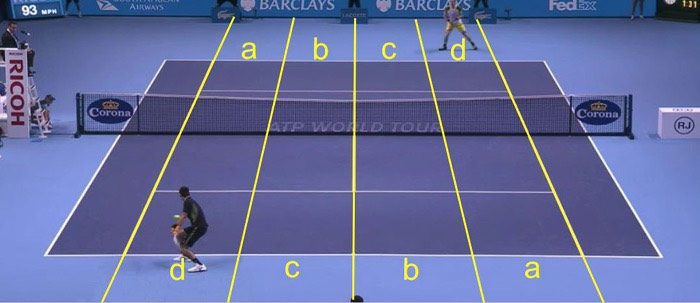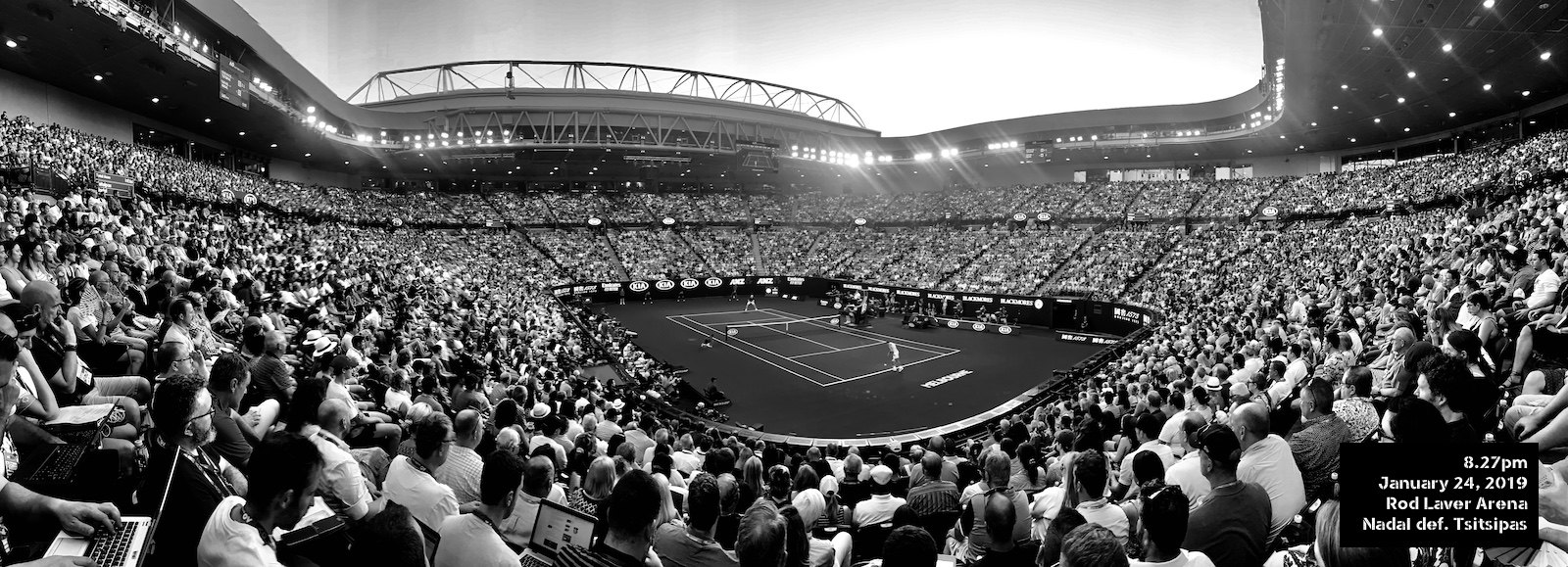Serve +1 Data | 2nd Serves In The Deuce Court
Here are the 2nd serve win percents for men and women at the 2019 US Open.
- Men = 50.0% (5984/11,955)
- Women = 45.5% (3124/6864)
There is no advantage in the men's draw when hitting a second serve. The win percentage is underwater for women. Trying to succeed behind your second serve is not an easy thing to accomplish.
Scenario: You are serving in the Deuce court and you have just missed your 1st serve. There is now a much higher probability that your second serve is going to be returned in the court and a baseline point will follow.
- Does it matter if you serve to the forehand or backhand return?
- Would you rather be standing in A, B, C or D for your Serve +1 shot?
- Would you rather be hitting a Serve +1 forehand or backhand?
That's what we are here to find out. Let's let the percentages dictate our patterns of play.
Data Set
-
2019 US Open Men (right-handed players)
-
2nd Serves
-
Deuce court
-
Forehand & backhand returns
-
Serve +1 performance (totals / win %) in A, B, C, D.
Baseline Locations A,B,C,D.

Question: The majority of 1st serves in the Deuce court came back to Position C. Is it the same against 2nd serves?
Answer: Yes. 👇
MEN: Deuce Ct | Serve +1 Location Following A 2nd Serve
(Forehand & Backhand Returns)

- Position A - 22% of 2nd serves to the forehand come back cross court to Position A. That's the most in the Deuce court against 1st or 2nd serves. Only 14% of backhand returns made it over there. There are slightly more overall (18%) coming back wide to Position A than down the line to Position D. If you have a big backswing on your forehand and you don't like to be rushed in a Serve +1 situation, then serving to the backhand can help protect it.
- Position B - 36% of forehand returns are going to come straight back to Position B. Going deep down the middle works fine, especially if the return is deep. 28% of backhand returns come here. Once again, if the return is deep the server can easily be in trouble in Position B, with the big backswing of the forehand groundstroke being compromised.
- Position C - If you hit your 2nd serve to the backhand, then expect it to come to this location the most (39%). Overall, this is where returns were hit the most, at 35%. The goal here is not to accept hitting a Serve +1 backhand. Look to hit a run-around forehand and attack the opponent to Position A or D.
- Position D - Even from a comparatively weaker 2nd serve, Position D received the least amount of traffic at 16% overall. It's definitely easier to do it from a backhand return (18%) than a forehand return (14%).
Deuce Ct | Serve +1 Location In Deuce & Ad Ct

- Deuce & Ad Court - It's interesting that 1st serves were split 50-50 and 2nd serve returns are basically the same, with 51% to the Ad court and 49% to the Deuce court. Because the 2nd serve is hit slower, the returner is trying to get slightly more to the Serve +1 backhand.
QUESTION: 1st serves went 70% to the middle. Does the reduced power of the 2nd serve enable the returner to attack wide more?
ANSWER: Yes it does. 👇
MEN: Deuce Ct | Serve +1 Location Middle & Wide

- Middle & Wide - The 2nd serve does not pressure the returner as much as the 1st serve, therefore the returner can attack wider to Position A and D a little more. 70% of 1st serve returns go to B & C, and 66% of 2nd serve returns go there. It's all about risk vs. reward and it does not mean that returning down the middle is not attacking. When returning down the middle you still get to use depth, height, spin, power, court position and time to hurt the server. In fact, direction is still a weapon because you are returning right at the server and they have got to move sideways to get away from the ball quite often.

- Forehand Returns To A & D - When returns are hit down the middle of the court vs. a 2nd serve, the server wins more points. The worst combo for the server in the Deuce court is hitting a 2nd serve to the forehand return and the returner goes straight down the line and attacks Position D. The server only won 30% of those. That's much lower than the 51% the server wins with a 2nd serve to the backhand a return to B.
SUMMARY
-
Position C (35%) is where the majority of 2nd serve returns come back in the Deuce Ct.
-
66% are returned down the middle of the court to Positions B & C.
-
The server won 49% when a backhand return was hit & 44% when a forehand return was hit.
Data Set - 2019 US Open Women (right-handed players)
-
2nd Serves
-
Deuce court
-
Forehand & backhand returns.
-
Serve +1 performance (totals / win %) in A, B, C, D.
Question: For the men, the majority of 2nd serves in the Deuce court came back to Position C. Is it the same for the women?
Answer: No. 👇
Deuce Ct | Serve +1 Location Following A 2nd Serve
(Forehand & Backhand Returns)

- Position A - Very interesting that both Position A and Position C both had 196 returns hit to these specific locations. The breakdown was different, with a lot more forehand (133-91) landing in Position A. Basically, playing big and attacking cross court is the dominant return strategy for the women against second serves. It's all about play big and sticking with the natural angle. The server only won 35% overall hitting a Serve +1 forehand in Position A, which dropped to 32% against a forehand return. This is a really strong, high percentage pattern for the returner to attack 2nd serves.
- Position B - This is where most 2nd serve returns were hit, at 32%. This was fueled by the natural angle of the forehand return (137) much more than the backhand return (97). The server only won 43% of returns to Position B. A key tactic here is driving the return deep and taking time away from the backswing on the forehand return.
- Position C - This location received 27% of second serve returns, which was the exact same percentage as Position A. From a returner's perspective, this was by far the worst place to go after a 2nd serve return in the Deuce court. The server won 49% of points hitting their Serve +1 shot in Position C, which was much higher than the other locations. A key here is that when you attack a 2nd serve, you are trying to instantly force a Serve +1 error. When you attack a Serve +1 backhand, the backswing is typically quite simple, so it's not easy to immediately force an error - especially when you hitting the ball straight back to the server and not really using direction as a weapon.
- Position D - Attacking straight down the line to Position D seems like an afterthought, with only 15% of returns going to this location. You would think it would get more attention from the forehand return, but only 10% of forehand returns went to Position D. So what do the winning percentages say about this strategy? Position D was the equal best place for the returner to direct their return, with the server only winning 35% of points when they had to hit a Serve +1 shot in this location. Returning to Position D in the Deuce court against a 2nd serve certainly seems like an underrated strategy.
Deuce Ct | Serve +1 Location In Deuce & Ad Ct

- Deuce & Ad Court - The men directed 49% of their 2nd serve returns to the to Deuce court. The women were much higher at 59%. There is a bigger willingness to stay cross in the natural angle and not take on too much risk going as much straight ahead to Positions C and D.

- Middle & Wide - I had to double check the numbers but there were the same amount of returns to A and B as there were to A and D. 59% of returns went right down the middle (mainly to B) and 41% wide.

- Forehand Returns To A & D - Hitting a forehand to return to Positions A and D worked amazingly well, with the server only winning 32% to Position A and 31% in Position D when they started the point with a Serve +1 groundstroke. Those win percentages were much better for the server when the returner went right down the middle - effectively electing to not use direction as much to win the point. The server won 42% in B and 48% in C when the returner hit a forehand return against a 2nd serve in the Deuce court. The best performing location for the server was when the returner hit a backhand return to C. Hitting a forehand return was definitely more productive than hitting a backhand return, and going wide against a 2nd serve worked much better than down the middle.
SUMMARY: 2nd Serves In the Deuce Court
-
Attacking 2nd serves with forehand returns is superior than with a backhand return.
-
Only 10% of forehand returns went to Position D, while 33% went cross court wide to Position A.
-
The server did the best when the returner hit a backhand return to Position C.
